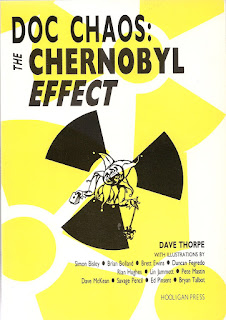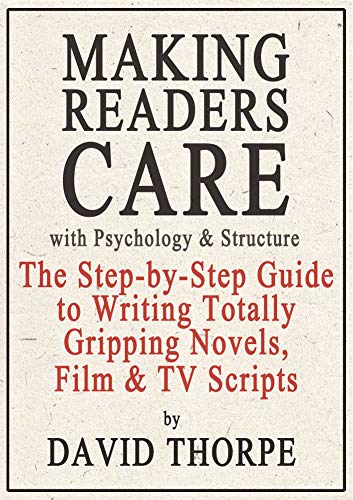"Why is this fantastic book prohibited? Are you people insane?"
 |
| Doc Chaos: the Chernobyl Effect original cover |
This is an email sent to me from Ray der Chrome in Amsterdam, containing a review of my book Doc Chaos: The Chernobyl Effect
It's also an amazing story.
... A long, long, long time ago, back when I was in high school during the Reagan years, a nuclear power plant exploded in what is now Ukraine, Chernobyl. It was a massive, life changing event.
Canned goods, parents putting their kids on iodine pills, cattle had to stay indoors. The nuclear fallout, the actual cloud containing the radioactive toxins, spread all over North-Western Europe, including Amsterdam, the Netherlands where I lived.
I was 16 then. I recall my mom sending me to the store to go out and 'buy some fresh cauliflower'. I remember standing there in the store, staring at all the crops of cauliflower and opting for canned goods instead. My mom wasn't too pleased.
I used to frequent a store in Amsterdam called: "The American Book Center" (ABC). They'd have cheap English language books and as a student/schoolkid I'd get a 10% discount. The store was quite popular (also for tourists) so they also had a coffee bar and a "comic section" where you could find "Watchmen" and "The Dark Knight Returns" in gorgeous high-quality hardcover English copies. [note: I edited these books in the UK)
They imported their own books from the US and UK. A couple of years after the Chernobyl disaster I was browsing the comic section and that's where I found... Doc Chaos.
Doc Chaos is an absolutely FANTASTIC work of art. An instant cult classic.
 |
| Doc Chaos: the Chernobyl Effect artwork by Dave McKean |
It's a novel with artwork thrown in, sort of a graphic novel-lite if you will. Doc Chaos is a fictional character. He represents "science" run amok. He IS 'science', he is living radioactivity. He just wants to be set free.
Thankfully the engineers at Chernobyl did just that. The book takes us through the disaster in Ukraine in 1986 in a unique way. The style of writing is like a William Burroughs-esque living nightmare of this beast that wants to be set free, wants to contaminate our world, this beast we simply cannot control.
I was so impressed with the book that I added it to my reading list. As I was graduating high-school (w/ Latin and Greek, the highest level), we were obligated to deliver (for our all our language courses, German, French, Spanish, Dutch and English) a reading list consisting of 10-12 books. In total we had to gather 20 "points".
The point system left something to be desired since it was based on number of pages. So a 300 page dumb book, will get you 3 points. A 200 page dumb book will get you 2 points. And a very clever, creative and unique book like "Doc Chaos" will get you a mere 1 point, since it's under 200 pages :(
Teachers have to "approve" your reading list. "Doc Chaos" was refused. Needless to say I objected.
Why is this fantastic book prohibited? Are you people insane?
My English teachers were quite clear: The book contains pictures, artwork, so its a comic book, not a real book. I was quite offended and took my case to the principal and board of the school. They held a formal hearing and everything.
The entire English faculty was there. "It's under 200 pages, it contains pictures, so no, not allowed". I calmly listened to their nonsense for a bit and then asked: Has anybody actually read this book? Turns out.... nobody did :)
The principal and board then asked the English faculty: Why didn't you read this book? (Now this is before Internet, 1988-1989, so...) "Well we do not know where he got it and we never heard of it".
I explained where I got the book, but alas, after numerous phonecalls with the American Book Center, no copies were available, they'd have to import more copies but those would arrive too late for my final (diploma) oral English exams.
I then offered to loan my copy to the school who used a regular copy-machine to make several copies of the book. (And yes, that's technically "piracy"). English staff then read the book and quite quickly came to the following conclusion:
Doc Chaos is an intellectual and creative tour-de-force. We're quite pleased that this student has taken a liking to such challenging material.
Not only was the book allowed on my reading list... I got 3 points for it, even though it was well under 300 pages.
As far as I am aware... after so many years, Doc Chaos is still the only graphic novel / artwork that deals with the Chernobyl disaster, the worst nuclear accident in human history.
Now some 30 yrs later, this rare and obscure little book has become a true cult classic.
I encourage everybody to read it. I give it 5 stars.
... And 3 points :)
Feel free to use this review anywhere you like and yes you can add my name: Ray van Chrome.
The book contains 12 illustrations by prominent stars of the comics art world: Simon Bisley ~ Brian Bolland ~ Brett Ewins ~ Duncan Fegredo ~ Rian Hughes ~ Lin Jammett ~ Pete Mastin ~ Dave McKean ~ Savage Pencil ~ Ed Pinsent ~ Bryan Talbot.
You can buy the book here: http://davidthorpe.info/imagination/buy-davids-fiction/#DC
Read about it here: http://davidthorpe.info/imagination/the-chernobyl-effect/


